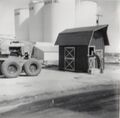Category:Concrete Elevators: Difference between revisions
(Created page with "These photos are believed to have been taken by Otto Mahrt during the spring and summer of 1952 and 1954. This belief is largely circumstantial. He was a farmer and retired to Reardan about that time. January 10, 1952 Washington Grain and Milling company elevators burned to the ground at Reardan destroying 100,000 bushels of storage capacity. This at a time when both the Washington Grain and Milling company and the Reardan Grain Growers were storing grain on the ground...") |
No edit summary |
||
| (One intermediate revision by the same user not shown) | |||
| Line 8: | Line 8: | ||
'''July 14, 1952 Spokesman-Review''' Two workers injured when staging for scale house collapsed. | '''July 14, 1952 Spokesman-Review''' Two workers injured when staging for scale house collapsed. | ||
[[category: elevators]] | |||
[[Category:Photos That Tell a Story]] | |||
Latest revision as of 15:08, 25 March 2023
These photos are believed to have been taken by Otto Mahrt during the spring and summer of 1952 and 1954. This belief is largely circumstantial. He was a farmer and retired to Reardan about that time.
January 10, 1952 Washington Grain and Milling company elevators burned to the ground at Reardan destroying 100,000 bushels of storage capacity. This at a time when both the Washington Grain and Milling company and the Reardan Grain Growers were storing grain on the ground due to increased production in the area.
The Reardan Grain Growers contracted Larson-Bradshaw of Spokane to construct concrete grain elevators for the 314,000 bushel north elevator on April 21, 1952 and for the 670,000 bushel south elevator on March 4, 1954.
Assuming that the elevators were built in the same manner as the grain elevators at Buffalo, NY using a technique developed in the early 1900s [1]. The construction of the elevators use a circular slip form that is jacked at the rate of 6 inches per hour to give the cement at the bottom of the form time to set before sliding the form upward. Screw jacks are placed every seven feet. A jackman would have up to 12 jacks to tend to and had to give each jack one turn every two and and a half minutes. Progress had to be steady and consistent to keep the forms level and flat. Pouring went on twenty-four hours a day for about eight days to build the 100 foot elevators. Pouring continuously in this fashion allows the concrete to chemically bond through the entire structure without gaps.
July 14, 1952 Spokesman-Review Two workers injured when staging for scale house collapsed.
Media in category "Concrete Elevators"
The following 21 files are in this category, out of 21 total.
- 1952-04-16-elevator-ground-breaking-1600.jpg 1,350 × 900; 698 KB
- 1952-05-04-000-feet-pour-1600.jpg 1,165 × 900; 526 KB
- 1952-05-04-021-feet-pour-1600.jpg 1,356 × 900; 494 KB
- 1952-05-05-020-feet-pour-1600.jpg 1,171 × 900; 496 KB
- 1952-05-05-022-feet-pour-1600.jpg 1,174 × 900; 168 KB
- 1952-05-06-023-feet-pour-1600.jpg 1,383 × 900; 567 KB
- 1952-05-07-031-feet-pour-1600.jpg 1,173 × 900; 494 KB
- 1952-05-11-090-feet-pour-1600.jpg 704 × 900; 373 KB
- 1952-05-11-092-feet-pour-1600.jpg 699 × 900; 344 KB
- 1952-05-11-099-feet-pour-1600.jpg 696 × 900; 356 KB
- 1952-05-12-110-feet-head-pour-1600.jpg 614 × 900; 278 KB
- 1952-05-13-110-feet-lower-slip1-1600.jpg 1,327 × 900; 411 KB
- 1952-05-13-110-feet-lower-slip2-1600.jpg 608 × 900; 277 KB
- 1953-08-20-grain-pile-building-1600.jpg 717 × 900; 122 KB
- 1953-08-20-grain-pile-fence-1600.jpg 1,129 × 900; 132 KB
- 1954-05-04-020-feet-pour-1600.jpg 1,341 × 900; 486 KB
- 1954-05-08-029-feet-pour-1600.jpg 1,155 × 900; 265 KB
- 1954-05-09-030-feet-pour-1600.jpg 1,348 × 900; 233 KB
- 1954-05-10-040-feet-pour-1600.jpg 592 × 900; 301 KB
- 1962-beautification-167d-road-grader-red-barn-elevators.JPG 607 × 599; 61 KB




















